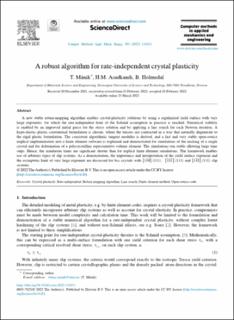| dc.contributor.author | Manik, Tomas | |
| dc.contributor.author | Moradi Asadkandi, Hassan | |
| dc.contributor.author | Holmedal, Bjørn | |
| dc.date.accessioned | 2023-03-06T12:22:23Z | |
| dc.date.available | 2023-03-06T12:22:23Z | |
| dc.date.created | 2022-04-10T13:08:10Z | |
| dc.date.issued | 2022 | |
| dc.identifier.citation | Computer Methods in Applied Mechanics and Engineering. 2022, 393 . | en_US |
| dc.identifier.issn | 0045-7825 | |
| dc.identifier.uri | https://hdl.handle.net/11250/3056038 | |
| dc.description.abstract | A new stable return-mapping algorithm enables crystal-plasticity solutions by using a regularized yield surface with very large exponents, for which the rate-independent limit of the Schmid assumption in practice is reached. Numerical stability is enabled by an improved initial guess for the stress solution and by applying a line search for each Newton iteration. A hypo-elastic–plastic corotational formulation is chosen, where the tensors are contracted in a way that naturally degenerate to the rigid plastic formulation. The consistent algorithmic tangent modulus is derived, and a fast and very stable open-source implicit implementation into a finite element software is explained and demonstrated for simulations of the necking of a single crystal and for deformation of a polycrystalline representative volume element. The simulations run stable allowing large time steps. Hence, the simulation times are significant shorter than for explicit finite element simulations. The framework enables use of arbitrary types of slip systems. As a demonstration, the importance and interpretation of the yield surface exponent and the asymptotic limit of very large exponent are discussed for bcc crystals with slip systems. | en_US |
| dc.language.iso | eng | en_US |
| dc.publisher | Elsevier | en_US |
| dc.rights | Navngivelse 4.0 Internasjonal | * |
| dc.rights.uri | http://creativecommons.org/licenses/by/4.0/deed.no | * |
| dc.title | A robust algorithm for rate-independent crystal plasticity | en_US |
| dc.title.alternative | A robust algorithm for rate-independent crystal plasticity | en_US |
| dc.type | Peer reviewed | en_US |
| dc.type | Journal article | en_US |
| dc.description.version | publishedVersion | en_US |
| dc.source.pagenumber | 0 | en_US |
| dc.source.volume | 393 | en_US |
| dc.source.journal | Computer Methods in Applied Mechanics and Engineering | en_US |
| dc.identifier.doi | 10.1016/j.cma.2022.114831 | |
| dc.identifier.cristin | 2016453 | |
| dc.relation.project | Norges forskningsråd: 315727 | en_US |
| cristin.ispublished | true | |
| cristin.fulltext | original | |
| cristin.qualitycode | 2 | |

